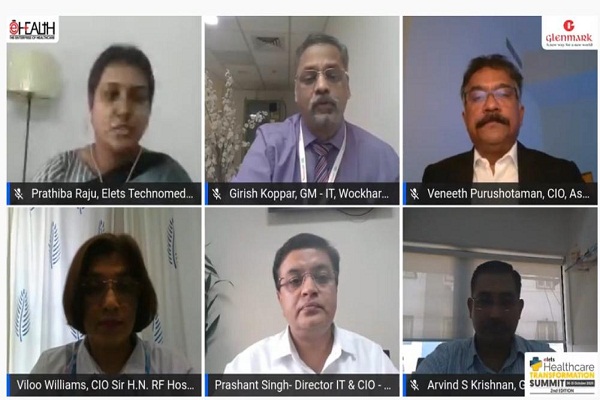
A spectrum of panelists discussed various aspects of Electronic Health Record while participating during the panel discussion on ‘Future of EHR in India: Challenges and Opportunities’ at the 2nd edition of the Healthcare Transformation Summit.
Initiating the session as a moderator, Girish Koppar, General Manager – IT, Wockhardt Hospitals, said: “In India, there are guidelines on EMR but no policy. Guidelines are now effectively followed by some hospitals. EMR was there but it has picked up in last decade. Medical fraternity has other responsibilities too apart from patient care. Technology has helped them a lot in speech to text format. Their focus is more on patient than EMR. At times they are reluctant to this transformation. Mindset changes if one witnesses benefits of any applications. EMR implementation comes from organizational level not from IT point. Cost shouldn’t be factor as long as it is beneficial for patients.”

Giving the details about what is EHR and how it is useful, Arvind Sivarama Krishnan, Group CIO, Apollo Hospitals, said: “Electronic Health Records happens within the health system while Electronic Health Record is combinational longitudinal records of patient across health systems. EHR is part of health system records that are not always given to patients like nursing notes and all. It is for internal care process. It is seamless longitudinal care record across care setting so that no health information is lost when a patient is going through various treatment and providers receive the patient.”
Also read: EHR–A basic tool to Bolster Digital Health Infra
“No record gets lost, that is the objective. There are EHR standards by Ministry of Health. But it is more like guidelines or advisory. Internationally, there are several guidelines which regulate care processes,” he said.

Prashant Singh, CIO, Max & BLK Hospitals, underlined challenge of EHR/EMR when acquisition happens. He said: “Merger and acquisition has its own set of challenges—both technically and overall. We picked and chose from best practices and tried to incorporate in the larger ecosystem. Rather than changing things in 14 hospitals, it is better to change in one single hospital. We have already rolled out financial system, business intelligence tools and ERP. We have already embarked on the journey as far as EMR/EHR is concerned. We are in the transitional phase. OT EMR adoption is around 65 percent. IPD EMR adoption is 80 percent. Everybody is aware about challenges in implementing EMR –change management and fear of productivity loss. There is a healthy level of competition within same group. If one or two hospitals have high adoption of EMR, that encourages others to adopt the same in their place too.”
Viloo Williams,CIO Head Transformation,Sir HN Reliance Foundation Hospital, stated that EMR implementation is more about mindset. “Old hospitals are not that mature in terms of adoption of EMR in comparison to new hospital. Adopting EMR is more of a mindset than anything else. Senior doctors are little apprehensive for pro-digitization. Use of paper records is more prevalent in these 40-50 years old hospitals. HN Reliance is not really the Green field hospital, but it conforms to the green building concept. It is brown field hospital with completely new structure, design and format. Digital adoption is very high,” she said.
“We are striving to further ensure that we could maintain the digitization. EMR is integral part of EHR.EMR doesn’t need to be a part of HIS as mandatory requirements. But without that you can’t really digitize the medical and clinical side of HIS which basically addresses administrative quality of hospital. Digitization comprises all—administrative, billing and registration. For medical or clinical side, EMR is important. For overall digitization, EMR is mandatory requirement.”
Veneeth Purushotaman, CIO, Aster DM Healthcare highlighted regulatory aspects ofEHR implementation. “It’s all about priority. It’s not the right thing attempting to change the current processes where we do operate manually into computer. There are lots of technologies involved in it. Change has to be accepted. Clinicians, hospital staff, doctors have to learn to use that system. If you try to convert the manual process into computer mode, it doesn’t help you. Rather you need to revisit the whole process and optimize and change it. HIS is limited to billing processes. Whole focus to use it as EHR/EMR and to capture patients’ record is still on paper. In India, we don’t have regulatory framework on EHR. In foreign countries, payers or insurance companies drive the whole things. They are very clear about processes and transparency at each level. In India, there is a various degree of EMR adoption as there is no mandatory thing,” he said.
Be a part of Elets Collaborative Initiatives. Join Us for Upcoming Events and explore business opportunities. Like us on Facebook , connect with us on LinkedIn and follow us on Twitter , Instagram.












